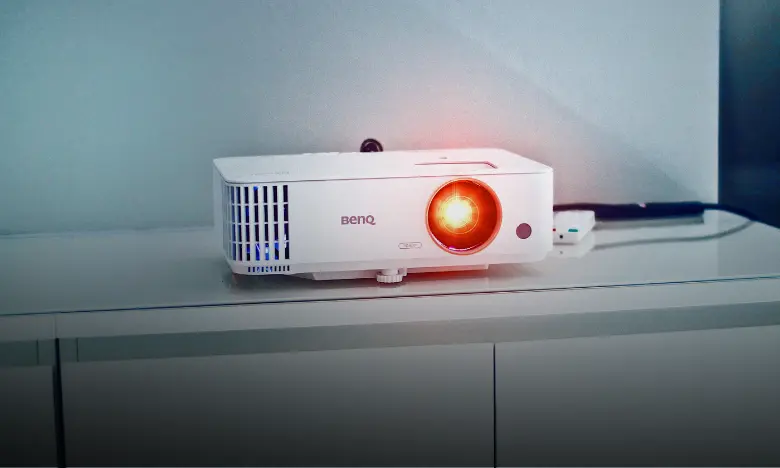Table of Contents
Introduction
If you’ve ever wished your gaming sessions felt larger than life, the gaming projector might be the perfect upgrade for your setup. Unlike traditional TVs or monitors, projectors offer massive screen sizes, cinematic immersion, and modern features like 4K HDR, low latency, and high refresh rates that can transform your experience. In this article, we’ll break down the five essential features that define the best gaming projectors today. We’ll also compare models, share benchmarks, and answer FAQs so you can make the right buying decision.
1. 4K & HDR: Visual Fidelity That Elevates Every Game
When it comes to visuals, 4K resolution paired with High Dynamic Range (HDR) has redefined gaming immersion. Leading models like the Hisense C2 Ultra deliver breathtaking detail and color accuracy. With support for Dolby Vision and the ability to project up to 300 inches, it creates a massive cinematic battlefield.
Other noteworthy mentions include the JMGO N1 Ultra, known for value while still providing 4K HDR brilliance. HDR ensures deep blacks and brighter whites, making every environment—from post-apocalyptic landscapes in Fallout to lush fantasy realms in Elden Ring—feel more lifelike.
Mini-Comparison: 4K HDR Leaders
| Model | Resolution | HDR Support | Max Screen Size | Special Feature |
|---|---|---|---|---|
| Hisense C2 Ultra | 4K | Dolby Vision | 300″ | HDMI 2.1 + 240Hz |
| JMGO N1 Ultra | 4K | HDR10+ | 200″ | Budget-friendly design |
| BenQ X3100i | 4K (pixel shift) | HDR10 | 200″ | Low input lag for esports |
2. Ultra-Low Input Lag & High Refresh Rates
Fast reflexes are critical in competitive gaming. That’s why low input lag and high refresh rates are defining features of a gaming projector. For context:
- <20 ms lag: Ideal for competitive gaming
- 20–50 ms lag: Acceptable for casual gaming
- >50 ms lag: Noticeable delay
The BenQ X3100i and NexiGo Aurora Pro MKII are standout performers here, offering up to 240Hz refresh rate with ultra-low latency (as low as 4.2ms). Imagine hitting every headshot in Call of Duty without any delay—it’s the projector equivalent of driving a sports car with zero lag on the throttle.
3. Brightness & Contrast: The Visual Power Combo
A crisp picture isn’t just about resolution—it’s also about brightness (lumens) and contrast. Ideally, you’ll want 3000+ lumens for gaming in lit rooms and a high contrast ratio to capture cinematic shadows.
Portability also plays a role. The BenQ GS50 and Anker Nebula series prove that compact designs can still deliver great performance, making them ideal for dorms, road trips, or casual living room setups.
Tip: If you’re setting up in a basement or dark room, you can save money with a lower-lumen projector, but for multipurpose spaces, brightness should be a top priority.
4. Throw Ratio: Big Screens in Small Spaces
Throw ratio determines how far your projector needs to sit from the wall to create a certain image size. This matters a lot if you’re short on space.
| Throw Type | Distance for 100″ | Best Use Case |
|---|---|---|
| Standard Throw | 8–10 ft | Large living rooms |
| Short Throw | 4–6 ft | Bedrooms & small gaming rooms |
| Ultra-Short Throw | 1–2 ft | Apartments, desks, or tight spaces |
A rising star in this category is the Xiaomi Laser Projector 3, which offers UST technology, 4K HDR, 120Hz, and smart AI auto-focus—all at an impressive price point. For gamers in apartments or smaller rooms, this makes a projector for gaming more practical than ever.
5. Audio, Smart Features & Connectivity
While visuals get all the hype, audio and connectivity often decide real-world usability. Projectors like the Hisense C2 Ultra feature integrated subwoofers and HDMI 2.1 support, meaning you can plug in a PS5 or Xbox Series X with zero hassle.
The Valerion VisionMaster Pro 2, meanwhile, comes loaded with Google TV, multiple HDMI ports, and a 240Hz refresh rate. However, its built-in speakers are weaker, making it best paired with external sound systems.
Xiaomi’s Laser Projector 3 goes a step further with HyperOS smart features, Dolby Audio, and adaptive brightness, ensuring it adapts to your environment seamlessly.

Bonus: Real-World Scenarios & Case Studies
- Esports Gamers: BenQ X3100i provides lightning-fast responsiveness.
- Cinematic RPG Fans: Hisense C2 Ultra’s HDR + subwoofer makes Skyrim or Final Fantasy XIV feel epic.
- Portable Setup: BenQ GS50 or Anker Nebula brings gaming outdoors on a summer night.
FAQs About Gaming Projectors
Q1: What is the best gaming projector for competitive play?
The BenQ X3100i and Hisense PX3 Pro are both excellent, offering refresh rates up to 240Hz and input lag under 20ms.
Q2: Is 4K really necessary in a gaming projector?
Yes—4K enhances immersion, especially for story-driven games. Hisense C2 Ultra and NexiGo Aurora Pro MKII excel in this area.
Q3: Which gaming projector works best in small rooms?
The Xiaomi Laser Projector 3 and Hisense PX3 Pro provide ultra-short throw setups, allowing massive screens from just a few inches away.
Q4: Can I use a gaming projector for cloud gaming?
Yes, many models with HDMI 2.1 and smart OS (like Xiaomi Laser Projector 3) are compatible with platforms like Xbox Cloud Gaming and Nvidia GeForce Now.
Conclusion
The modern gaming projector is more than just a niche gadget—it’s a serious upgrade for gamers who want cinematic immersion, competitive performance, and flexible setups. From 4K HDR visuals to lightning-fast input lag, the latest models are designed with players in mind.
If you’re upgrading, look for these five features: 4K HDR, low latency, brightness, throw ratio flexibility, and smart connectivity. With the right choice, you’ll turn every gaming session into an unforgettable event.

